Cells and Fugu Response to Capsid of BFNNV Genotype
Abstract
1. Introduction
2. Materials and Methods
2.1. Cell Lines and Fish
2.2. Plasmids Construction
2.3. Subcellular Localization of Modified Plasmids in EPC Cells
2.4. Cell Counts
2.5. Gene Expression Responses of Cells to BFNNV CP
2.6. Immunoregulation of pcDNA3.1-CP in T. rubripes
2.6.1. The Retention Time of the Plasmid In Vivo
2.6.2. Detection of Immune Factors after Plasmid Injection
2.7. Statistical Analysis
3. Results
3.1. Capsid Localization and Cell Response
3.2. Gene Expression Responses of Cells to BFNNV Capsid
3.3. Plasmid Tested in Various Tissues after Injection
3.4. Immune Response of T. rubripes after Plasmid Injection
4. Discussion
Supplementary Materials
Author Contributions
Funding
Institutional Review Board Statement
Informed Consent Statement
Data Availability Statement
Acknowledgments
Conflicts of Interest
References
- Bandín, I.; Souto, S. Betanodavirus and VER Disease: A 30-year Research Review. Pathogens 2020, 9, 106. [Google Scholar] [CrossRef]
- Huang, S.; Wu, Y.; Su, L.; Su, T.; Zhou, Q.; Zhang, J.; Zhao, Z.; Weng, S.; He, J.; Xie, J. A single-chain variable fragment antibody exerts anti-nervous necrosis virus activity by irreversible binding. Aquaculture 2022, 552, 738001. [Google Scholar] [CrossRef]
- Mao, M.G.; Wen, S.H.; Perálvarez-Marín, A.; Li, H.; Jiang, J.L.; Jiang, Z.Q.; Li, X.; Sun, H.; Lv, H.Q. Evidence for and characterization of nervous necrosis virus infection in pacific cod (Gadus macrocephalus). Arch. Virol. 2015, 160, 2237–2248. [Google Scholar] [CrossRef]
- Wang, Q.; Peng, C.; Yang, M.; Huang, F.; Qin, Q. Single-cell RNA-seq landscape midbrain cell responses to red spotted grouper nervous necrosis virus infection. PLoS Pathog. 2021, 17, e1009665. [Google Scholar] [CrossRef] [PubMed]
- Fichi, G.; Cardeti, G.; Cersini, A.; Mancusi, C.; Guarducci, M.; Di Guardo, G.; Terracciano, G. Bacterial and viral pathogens detected in sea turtles stranded along the coast of Tuscany, Italy. Vet. Microbiol. 2016, 185, 56–61. [Google Scholar] [CrossRef] [PubMed]
- Kim, Y.C.; Kwon, W.J.; Min, J.G.; Kim, K., II; Jeong, H.D. Complete genome sequence and pathogenic analysis of a new betanodavirus isolated from shellfish. J. Fish Dis. 2019, 42, 519–531. [Google Scholar] [CrossRef]
- Lin, K.B.; Fang, Q.S.; Wu, J.S.; Zhou, C.; He, L.B.; Lin, Q.; Wang, H.S. Preliminary study on blocking transmission of NNV in Epinephelus coioides. J. Fujian Fish. 2011, 33, 15–19. (In Chinese) [Google Scholar]
- Lampert, Y.; Berzak, R.; Davidovich, N.; Diamant, A.; Stern, N.; Scheinin, A.P.; Dan, T.; Morick, D. Indigenous versus Lessepsian Hosts: Nervous Necrosis Virus (NNV) in Eastern Mediterranean Sea Fish. Viruses 2020, 12, 430. [Google Scholar] [CrossRef]
- Liu, X.D.; Huang, J.N.; Weng, S.P.; Hu, X.Q.; Chen, W.J.; Qin, Z.D.; Dong, X.X.; Liu, X.L.; Zhou, Y.; Asim, M.; et al. Infections of nervous necrosis virus in wild and cage-reared marine fish from South China Sea with unexpected wide host ranges. J. Fish Dis. 2015, 38, 533–540. [Google Scholar] [CrossRef]
- Chen, W.; Liu, X.; Hu, X.; Wang, W.; Qin, Z.; Wang, Y.; Zhou, Y.; Liu, X.; Lin, L. Trend and research progress of nervous necrosis virus. J. Fish. China 2014, 38, 1666–1672. [Google Scholar]
- Johansen, R.; Sommerset, I.; Trud, B.; Korsnes, K.; Dannevig, B.H. Characterization of nodavirus and viral encephalopathy and retinopathy in farmed turbot, Scophthalmus maximus (L.). J. Fish Dis. 2010, 27, 591–601. [Google Scholar] [CrossRef] [PubMed]
- Nishizawa, T.; Furuhashi, M.; Nagai, T.; Nakai, T.; Muroga, K.; Asia, S. Genomic classification of fish nodaviruses by molecular phylogenetic analysis of the coat protein gene. Appl. Environ. Microb. 1997, 63, 1633–1636. [Google Scholar] [CrossRef]
- Grotmol, S.; Bergh, Ø.; Totland, G.K. Transmission of viral encephalopathy and retinopathy (VER) to yolksac larvae a possible route of the Atlantic halibut Hippoglossus hippoglossus: Occurrence of nodavirus in various organs and of infection. Dis. Aquat. Organ. 1999, 36, 95–106. [Google Scholar] [CrossRef] [PubMed]
- Toffan, A.; Panzarin, V.; Toson, M.; Cecchettin, K.; Pascoli, F. Water temperature affects pathogenicity of different betanodavirus genotypes in experimentally challenged Dicentrarchus labrax. Dis. Aquat. Organ. 2016, 119, 231–238. [Google Scholar] [CrossRef]
- Vendramin, N.; Toffan, A.; Mancin, M.; Cappellozza, E.; Panzarin, V.; Bovo, G.; Cattoli, G.; Capua, I.; Terregino, C. Comparative pathogenicity study of ten different betanodavirus strains in experimentally infected European sea bass, Dicentrarchus labrax (L.). J. Fish Dis. 2014, 37, 371–383. [Google Scholar] [CrossRef]
- Souto, S.; Olveira, J.G.; Dopazo, C.P.; Borrego, J.J.; Bandín, I. Modification of betanodavirus virulence by substitutions in the 3’ terminal region of RNA2. J. Gen. Virol. 2018, 99, 1210–1220. [Google Scholar] [CrossRef] [PubMed]
- Moreno, P.; Souto, S.; Leiva-rebollo, R.; Borrego, J.J.; Bandín, I.; Alonso, M.C. Capsid amino acids at positions 247 and 270 are involved in the virulence of betanodaviruses to European sea bass. Sci. Rep. 2019, 9, 14068. [Google Scholar] [CrossRef] [PubMed]
- Adachi, K.; Ichinose, T.; Takizawa, N.; Watanabe, K.; Kitazato, K.; Kobayashi, N. Inhibition of betanodavirus infection by inhibitors of endosomal acidification. Arch. Virol. 2007, 152, 2217–2224. [Google Scholar] [CrossRef]
- Watanabe, K.I.; Nishizawa, T.; Yoshimizu, M. Selection of brood stock candidates of barfin flounder using an ELISA system with recombinant protein of barfin flounder nervous necrosis virus. Dis. Aquat. Organ. 2000, 41, 219–223. [Google Scholar] [CrossRef] [PubMed]
- Catherine, C.; Niels, L.; Bertrand, C. DNA vaccination for finfish aquaculture. Fish Shellfish. Immun. 2019, 85, 106–125. [Google Scholar]
- Sun, Y.; Ding, S.S.; He, M.W.; Liu, A.; Zhou, Y. Construction and analysis of the immune effect of vibrio harveyi subunit vaccine and DNA vaccine encoding TssJ antigen. Fish Shellfish. Immun. 2020, 98, 45–51. [Google Scholar] [CrossRef] [PubMed]
- Xu, D.H.; Zhang, D.; Shoemaker, C.; Beck, B. Dose effects of a DNA vaccine encoding immobilization antigen on immune response of channel catfish against Ichthyophthirius multifiliis. Fish Shellfish. Immun. 2020, 106, 1031–1041. [Google Scholar] [CrossRef] [PubMed]
- Lan, N.T.; Kim, H.J.; Han, H.J.; Lee, D.C.; Kang, B.K.; Han, S.Y.; Moon, H.; Kim, H.J. Stability of virus-like particles of red-spotted grouper nervous necrosis virus in the aqueous state, and the vaccine potential of lyophilized particles. Biologicals 2018, 51, 25–31. [Google Scholar] [CrossRef] [PubMed]
- Ito, Y.; Okinaka, Y.; Mori, K.; Sugaya, T.; Nishioka, T.; Oka, M.; Nakai, T. Variable region of betanodavirus RNA2 is sufficient to determine host specificity. Dis. Aquat. Organ. 2008, 79, 199–205. [Google Scholar] [CrossRef]
- Guo, Y.X.; Dallmann, K.; Kwang, J. Identification of nucleolus localization signal of betanodavirus GGNNV protein α. Virology 2003, 306, 225–235. [Google Scholar] [CrossRef]
- Iwamoto, T.; Okinaka, Y.; Mise, K.; Mori, K.-I.; Arimoto, M.; Okuno, T.; Nakai, T. Identification of Host-Specificity Determinants in Betanodaviruses by Using Reassortants between Striped Jack Nervous Necrosis Virus and Sevenband Grouper Nervous Necrosis Virus. J. Virol. 2004, 78, 1256–1262. [Google Scholar] [CrossRef] [PubMed]
- Sommerset, I.; Nerland, A. Complete sequence of RNA1 and subgenomic RNA3 of Atlantic halibut nodavirus (AHNV). Dis. Aquat. Organ. 2004, 58, 117–125. [Google Scholar] [CrossRef] [PubMed]
- Chang, J.S.; Chi, S.C.; López, S. GHSC70 Is Involved in the Cellular Entry of Nervous Necrosis Virus. J. Virol. 2015, 89, 61–70. [Google Scholar] [CrossRef]
- Zhang, W.; Jia, K.; Jia, P.; Xiang, Y.; Lu, X.; Liu, W.; Yi, M. Marine medaka heat shock protein 90ab1 is a receptor for red-spotted grouper nervous necrosis virus and promotes virus internalization through clathrin-mediated endocytosis. PLoS Pathog. 2020, 16, e1008668. [Google Scholar] [CrossRef]
- Zhang, W.; Jia, P.; Lu, X.; Chen, X.; Weng, J.; Jia, K.; Yi, M. Capsid protein from red-spotted grouper nervous necrosis virus induces incomplete autophagy by inactivating the HSP90ab1-AKT-MTOR pathway. Zool. Res. 2022, 43, 98–110. [Google Scholar] [CrossRef]
- Petrucelli, L.; Dickson, D.; Kehoe, K.; Taylor, J.; Snyder, H.; Grover, A.; De Lucia, M.; McGowan, E.; Lewis, J.; Prihar, G.; et al. CHIP and Hsp70 regulate tau ubiquitination, degradation and aggregation. Hum. Mol. Genet. 2004, 13, 703–714. [Google Scholar] [CrossRef] [PubMed]
- Charette, S.J.; Lavoie, J.N.; Lambert, H.; Landry, J. Inhibition of Daxx-mediated apoptosis by heat shock protein 27. Mol. Cell Biol. 2000, 20, 7602–7612. [Google Scholar] [CrossRef] [PubMed]
- Zaher, K.S.; Ahmed, W.M. DNA Vaccines Against Viral Diseases of Aquaculture. Adv. Biol. Res. 2016, 10, 348–350. [Google Scholar]
- Qiu, D.K.; Xiong, Y.; Gong, Y.M.; Zheng, Y.Y.; Zhu, B. Dominant antigen of grass carp Reovirus and immunity assessment with DNA vaccine for grass carp. Aquaculture 2021, 530, 735948. [Google Scholar] [CrossRef]
- Zhang, X.Z.; Yue, W.W.; Bai, S.J.; Hao, H.N.; Song, Y.Y.; Long, S.R.; Liu, R.D.; Cui, J.; Wang, Z.Q. Oral immunization with attenuated salmonella encoding an elastase elicits protective immunity against Trichinella spiralis infection. Acta Trop. 2022, 226, 106263. [Google Scholar] [CrossRef] [PubMed]
- Chen, S.P.; Peng, R.H.; Chiou, P.P. Modulatory effect of CpG oligodeoxynucleotide on a DNA vaccine against nervous necrosis virus in orange-spotted grouper (Epinephelus coioides). Fish Shellfish. Immunol. 2015, 45, 919–926. [Google Scholar] [CrossRef] [PubMed]
- Gye, H.J.; Oh, M.J.; Nishizawa, T. Lack of nervous necrosis virus (NNV) neutralizing antibodies in convalescent sevenband grouper Hyporthodus septemfasciatus after NNV infection. Vaccine 2018, 36, 1863–1870. [Google Scholar] [CrossRef] [PubMed]
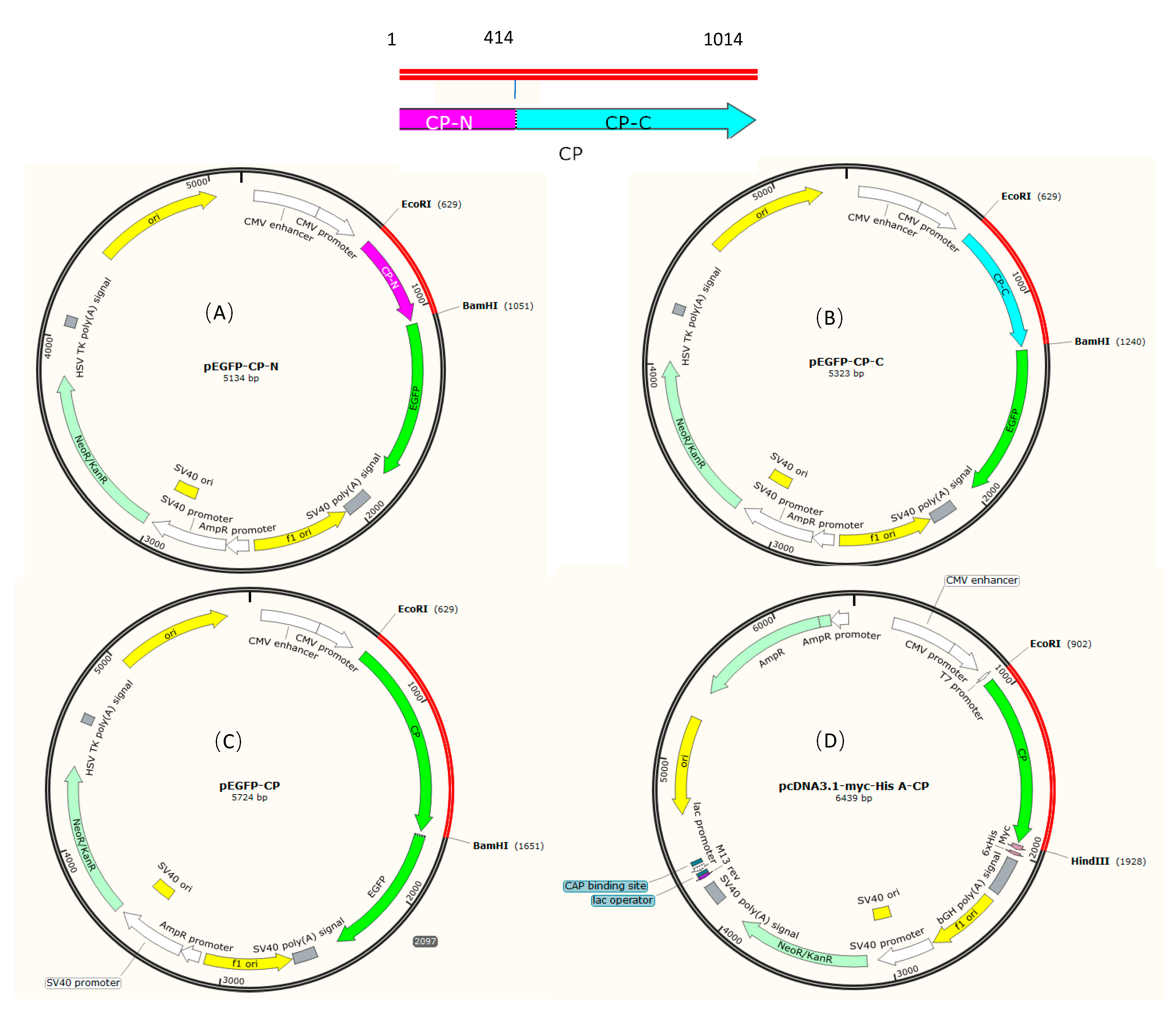
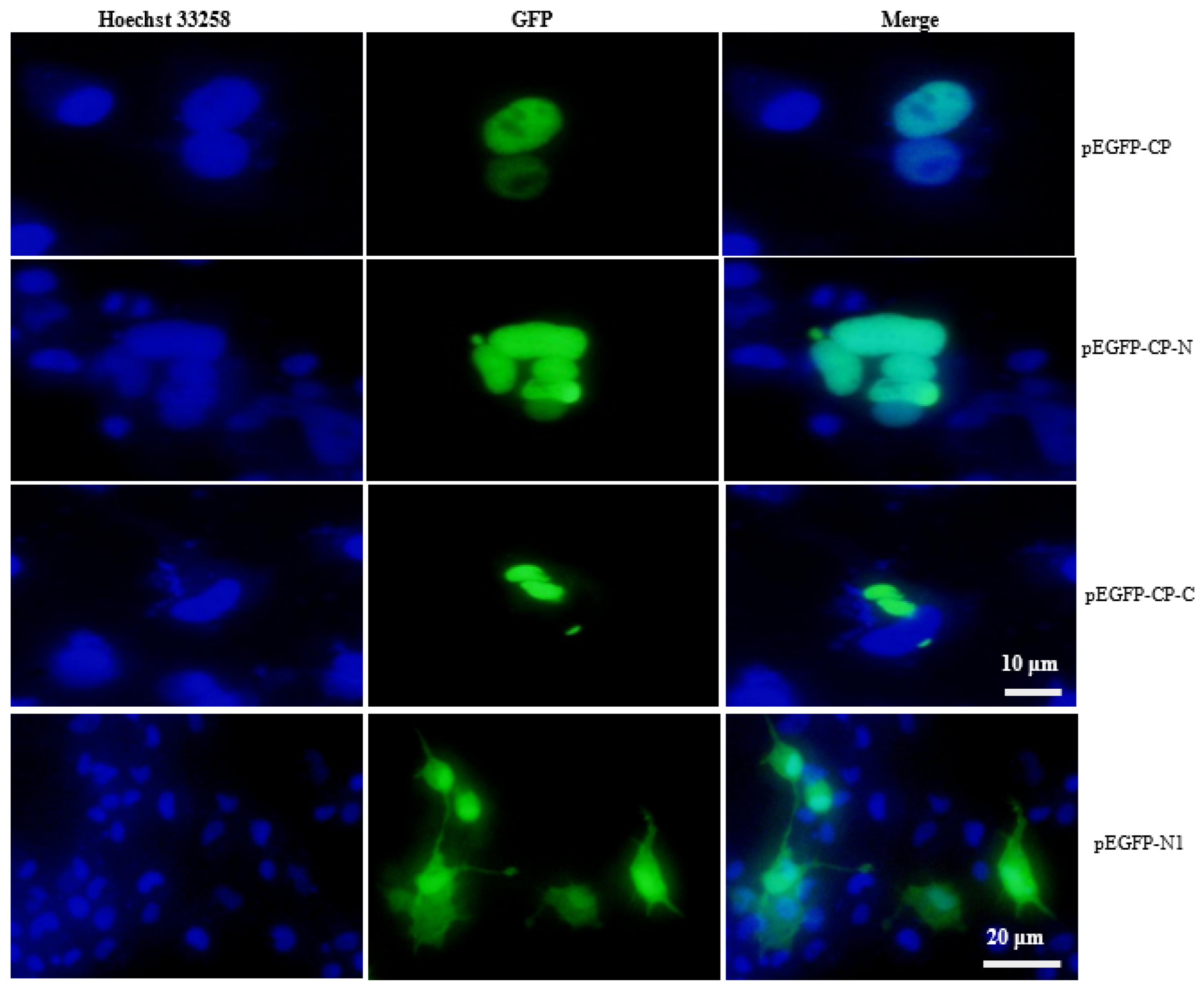


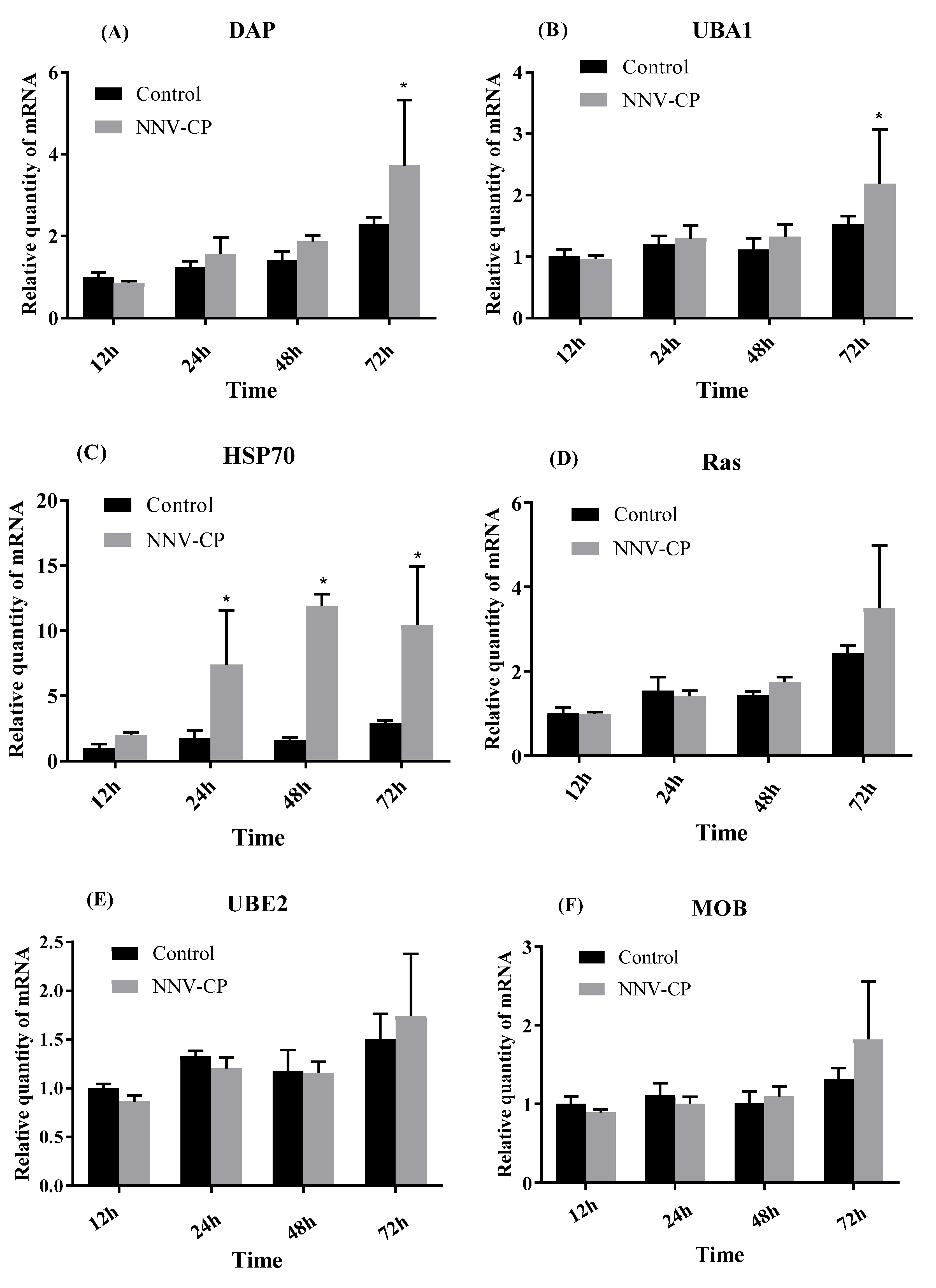
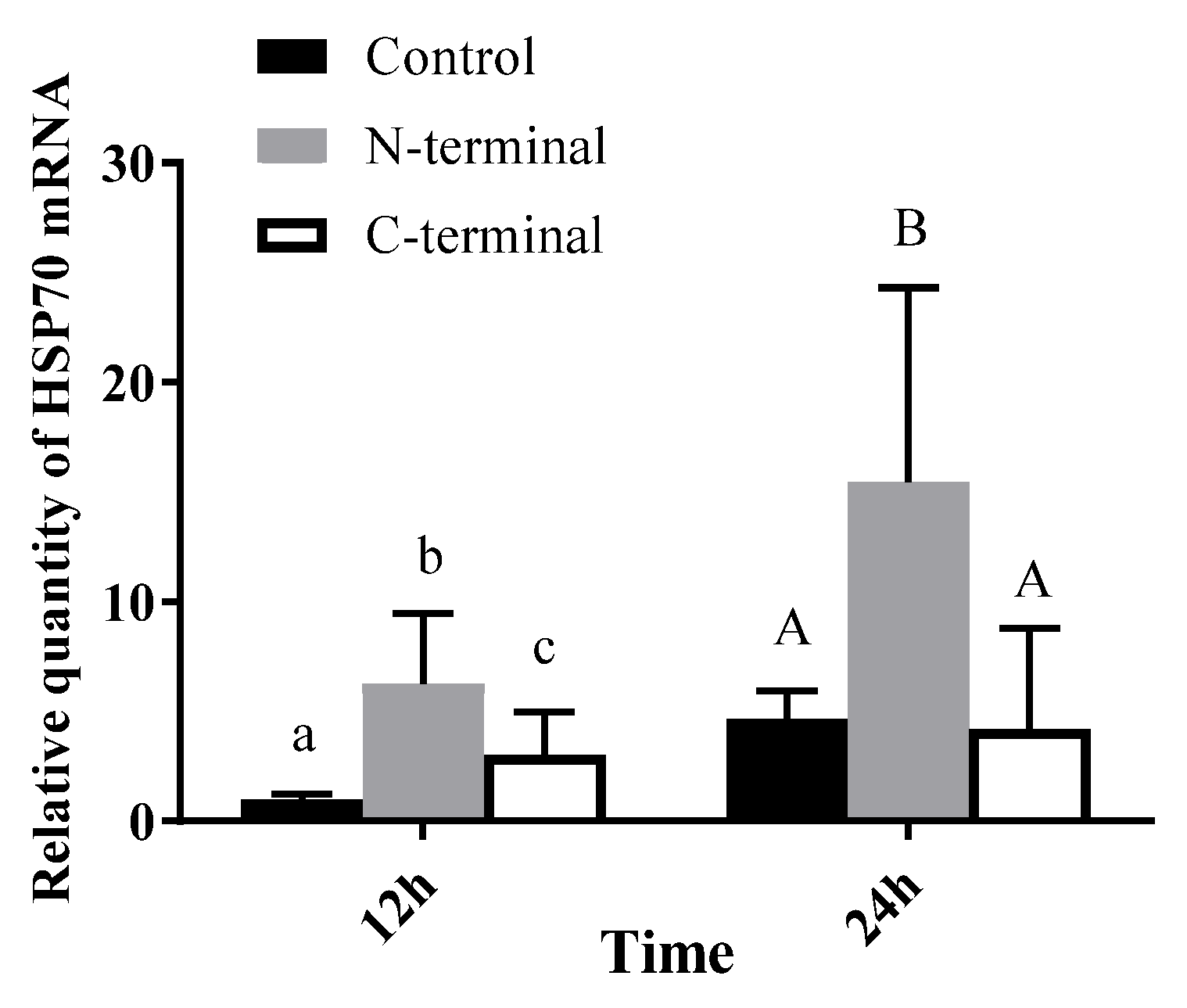
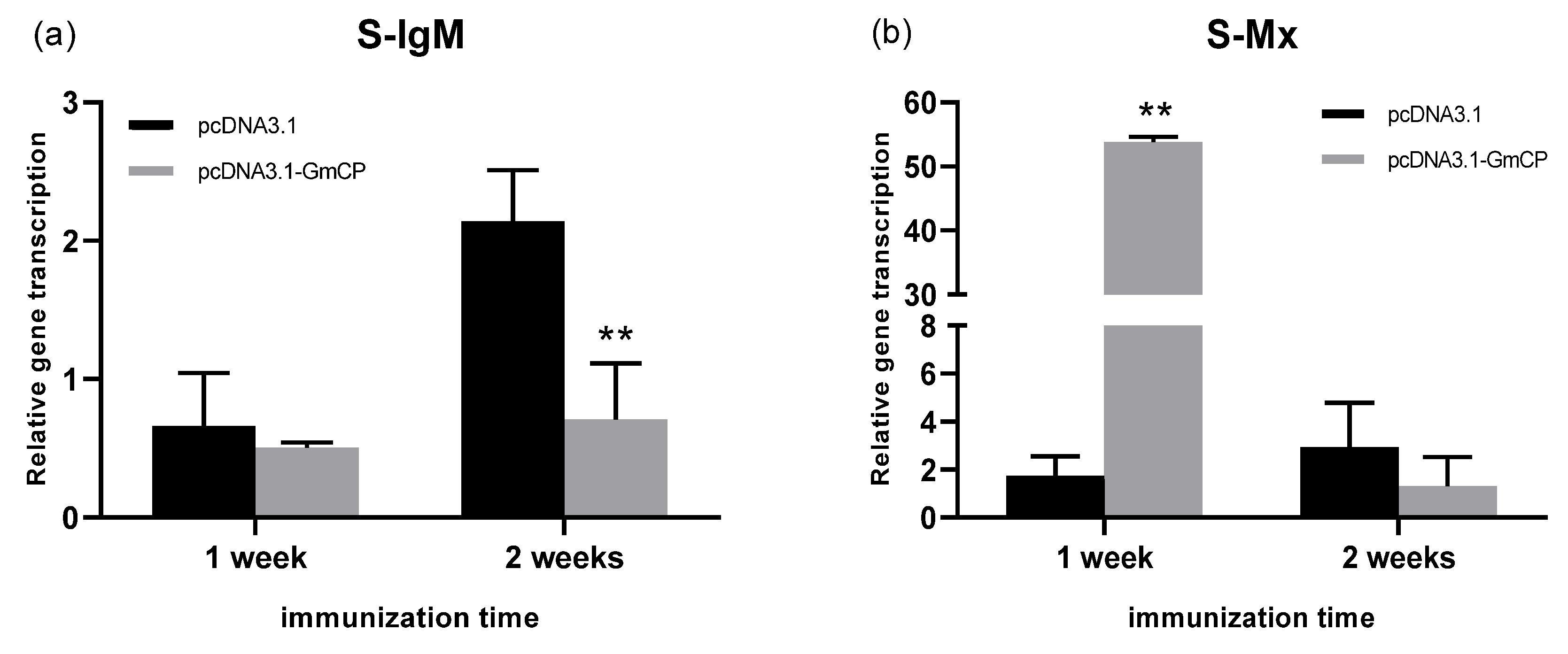
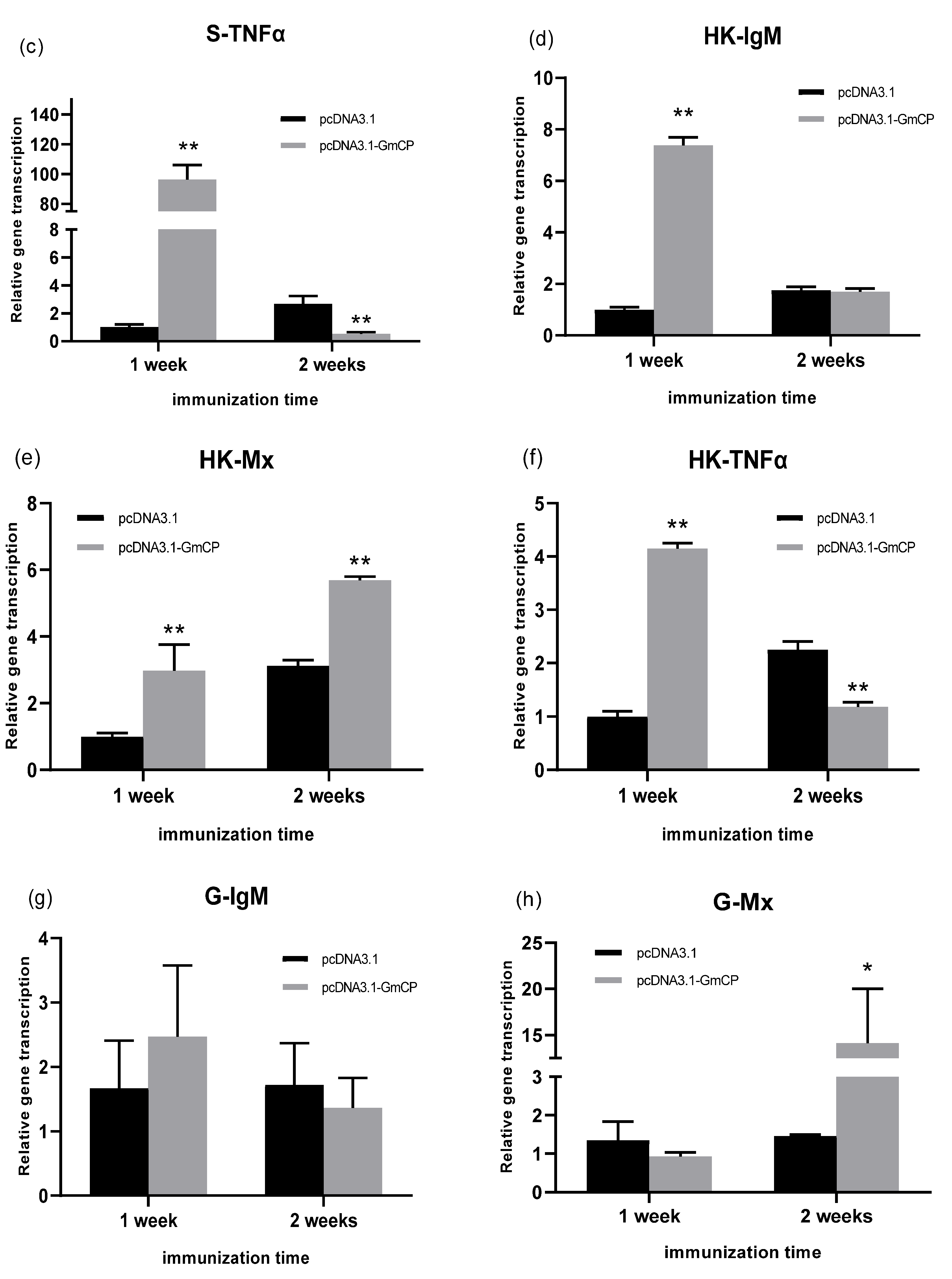
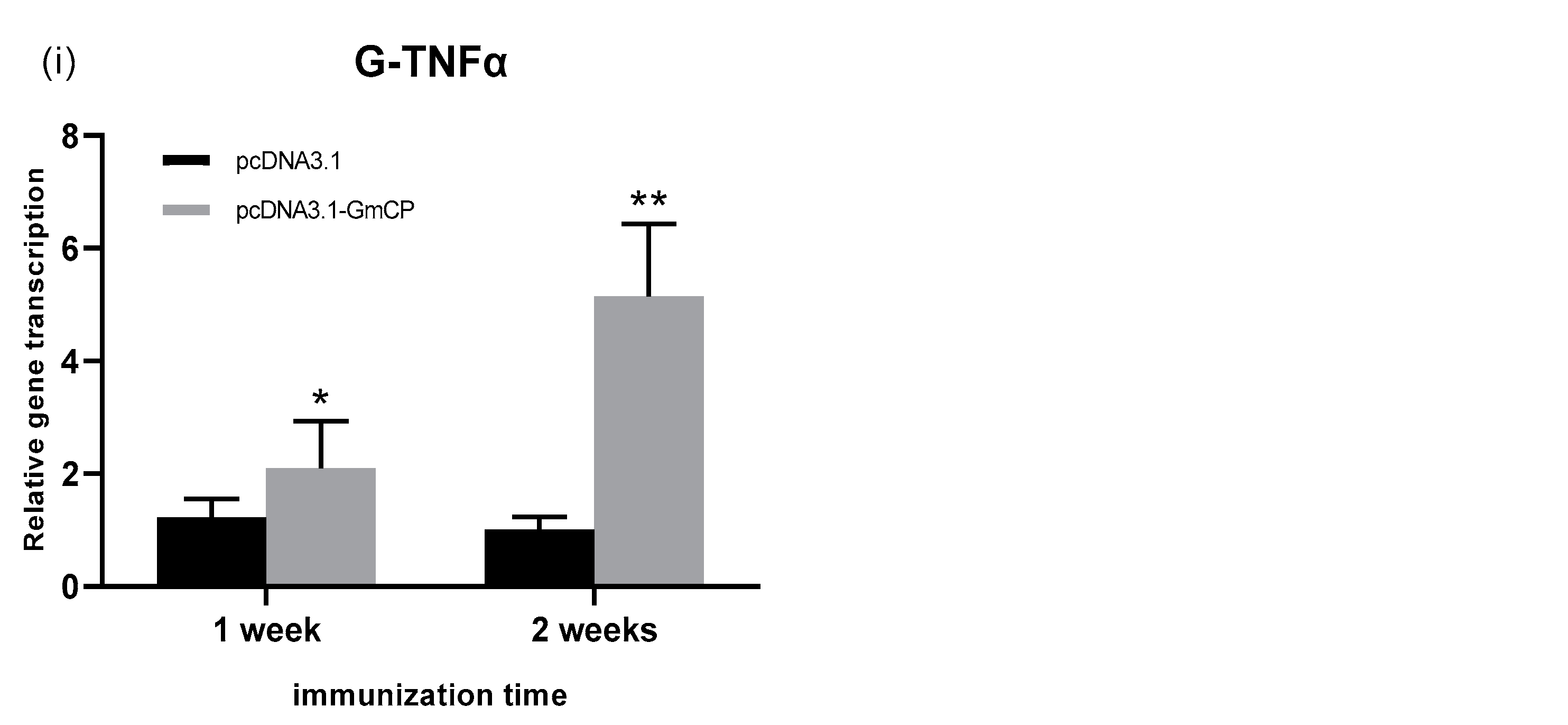
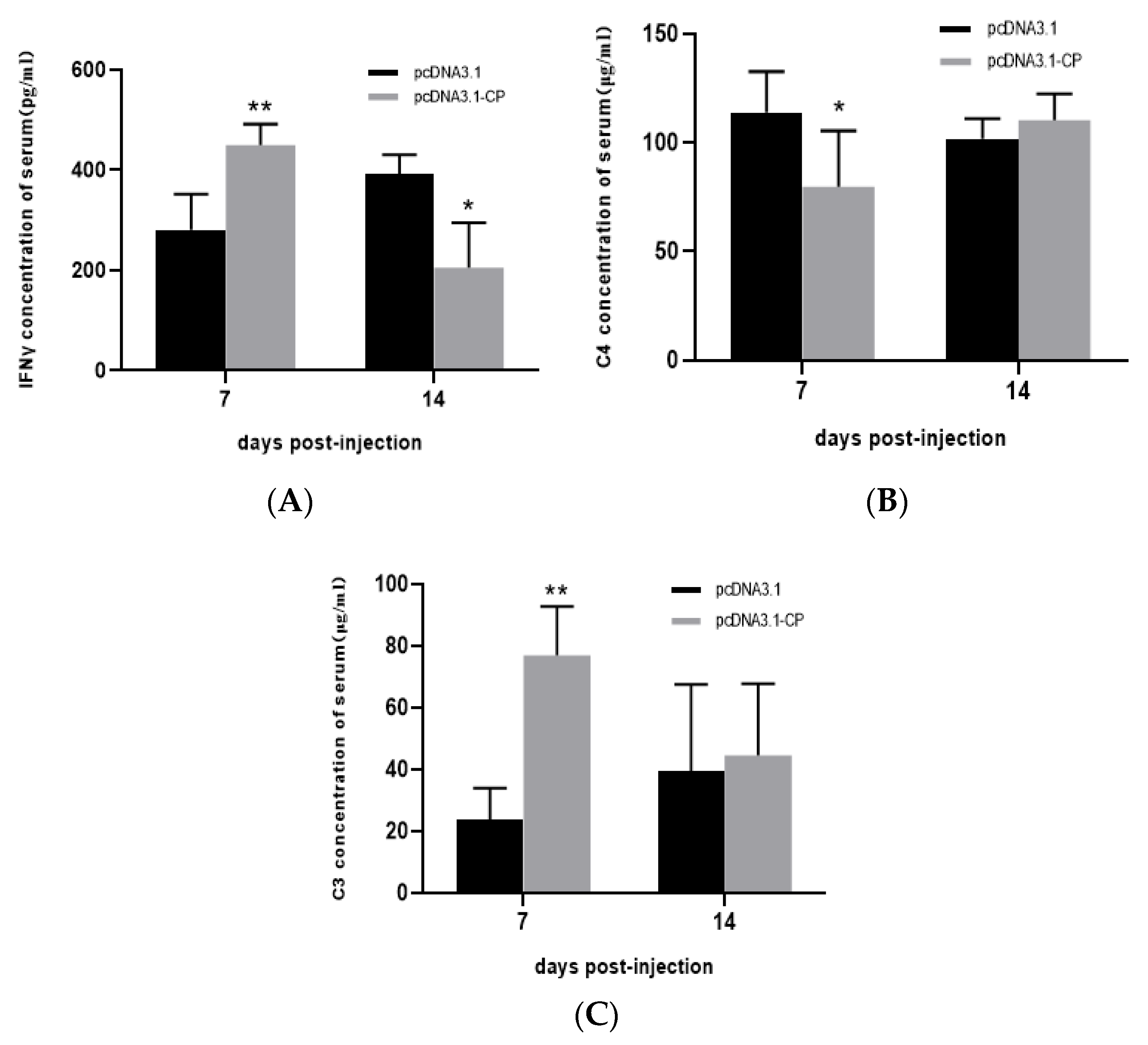
| Name | Seq. 5′→3′ | Purpose |
|---|---|---|
| P1592F | GGAATTCATGGTACGCAAAGGGAATAAG | Including EcoRI and BamHI restriction sites for pEGFP-CP construction |
| P1592R | CGGGATCCCGGTTTCCCGAGTCAGCCCGGGTG | |
| P1924F | CGGAATTCATGGTACGCAAAGGGAATAAGAAAT | Including EcoRI and BamHI restriction sites for pEGFP-CP-N construction |
| P1924R | CGGGATCCCGGAAGGTGTGGTCGCTGTCAGTTGG | |
| P1925F | CGGAATTCATGGACGCAATTCAAGCGACTCGTG | Including EcoRI and BamHI restriction sites for pEGFP-CP-C |
| P1925R | CGGGATCCCGGTTTCCCGAGTCAGCCCGGGTGAAG | |
| PEGFP-N1 | CGTCGCCGTCCAGCT CGACCAG | universal primer for pEGFP-N1 |
| HSP70-F1 | ATTGGAGATGCTGCTAAA | qPCR for Hsp70 in EPC cells |
| HSP70-R1 | GACTGCACTACTGGGTCA | |
| Ras-F1 | TTCTGGGTGAAGGAGTTA | qPCR for Ras in EPC cells |
| Ras-R1 | TCCTGAACATCGTGGTAG | |
| UBA1-F | CCCGAAAGTCCGCATTAC | qPCR for UBA1 in EPC cells |
| UBA1-R | AGCATTTGCCACTCCATC | |
| DAP-F1 | GTCGTCACTAAGGGAGATAAA | qPCR for DAP in EPC cells |
| DAP-R1 | TGGTGGATGTGCTGGTTG | |
| UBE2-F1 | AATGGCAGCATCTGTTTG | qPCR for UBE2 in EPC cells |
| UBE2-R1 | AATGGATCATCTGGGTTT | |
| MOB-F1 | CACTGGGCTGATGGAACT | qPCR for MOB in EPC cells |
| MOB-R1 | TGAGCGTAAACACGGAAG | |
| Eactin-F | GGCACTGCTGCTTCCTC | Internal control gene of qPCR in EPC cells |
| Eactin-R | ACCGCAAGACTCCATACCC | |
| β-actin-F | ATCCGTAAGGACCTGTATGC | Internal control gene of qPCR in T. rubripes |
| β-actin-R | AGTATTTACGCTCAGGTGGG | |
| qIgM-F | GTCATCATCAATCCCAAGC | qPCR for IgM in T. rubripes |
| qIgM-R | CCTCGTCCTCCCACCAAAT | |
| qMx-F | AGCCTGGTGGTTGTTCCG | qPCR for Mx in T. rubripe |
| qMx-R | AGATACCCAAAGTCCGTTC | |
| qTNFα-F | CTTTCCGAGTGACTTGCG | qPCR for TNF-α in T. rubripe |
| qTNFα-R | AGTGGTCTCAGTGCCGATG | |
| CP-F | TTCAAGCGACTCGTGGTG | qPCR for RNA2 gene detection |
| CP-R | CGCAGGTGTTCCCGTATT | |
| T7-F | CCAGCGTAGTTCGGTCCTC | Universal primer T7 |
| T7-R | GCTTCCTTTCGGGCTTTGT |
| Transcript id | p Value | q Value | Up-/Down-Regulated | NR/NT |
|---|---|---|---|---|
| TRINITY_DN25567_c4_g1 | 0 | 0 | up | gi|808157850|gb|AKC98253.1|capsid protein |
| TRINITY_DN26629_c1_g3 | 0 | 0 | up | gi|152956217|emb|CT956064.14|Zebrafish DNA sequence from clone CH211-248K16 in linkage group 7 |
| TRINITY_DN22595_c2_g1 | 0 | 0 | up | gi|108767286|ref|YP_636112.1|cytochrome c oxidase subunit II |
| TRINITY_DN26629_c2_g1 | 0 | 0 | up | gi|954431710|gb|KRY81076.1|Uncharacterized protein T4D_4496 |
| TRINITY_DN26045_c0_g3 | 0 | 0 | up | gi|685042682|emb|LN591207.1|Cyprinus carpio genome assembly common carp genome, scaffold 000028969 |
| TRINITY_DN26590_c3_g2 | 0 | 0 | down | gi|688611381|ref|XP_009295045.1|filamin-A isoform X1 |
| TRINITY_DN26695_c4_g1 | 0 | 0 | up | gi|148357120|ref|NP_001091866.1|uncharacterized protein LOC100037361 |
| TRINITY_DN26734_c0_g1 | 0 | 0 | up | gi|1024953445|ref|XM_016442040.1|low-density lipoprotein receptor-related protein 1-like |
| TRINITY_DN25436_c3_g3 | 0 | 0 | up | gi|914726992|gb|AKV94009.1|heat shock 70 kDa protein |
| TRINITY_DN26629_c1_g2 | 4.10 × 10−307 | 2.45 × 10−303 | up | gi|954411357|gb|KRY64374.1|hypothetical protein T4A_8672 |
| TRINITY_DN23848_c0_g1 | 5.70 × 10−119 | 7.18 × 10−116 | down | gi|1025064867|ref|XP_016335574.1|palladin-like |
| TRINITY_DN24829_c0_g10 | 1.95 × 10−102 | 4.42 × 10−99 | up | gi|632986665|ref|XP_007910363.1|serine/arginine-rich splicing factor 10-like |
| TRINITY_DN18738_c0_g1 | 1.90 × 10−96 | 1.80 × 10−93 | up | gi|34538600|ref|NP_904330.1|cytochrome c oxidase subunit I (mitochondrion) |
| TRINITY_DN24829_c0_g10 | 1.94 × 10−93 | 1.75 × 10−90 | up | gi|632986665|ref|XP_007910363.1|serine/arginine-rich splicing factor 10-like |
| TRINITY_DN23725_c2_g2 | 6.54 × 10−91 | 5.83 × 10−88 | down | gi|1025042229|ref|XP_016327971.1|integral membrane protein 2B-like |
| TRINITY_DN26608_c1_g2 | 1.73 × 10−87 | 1.48 × 10−84 | up | gi|1020496620|ref|XP_016086939.1|dnaJ homolog subfamily A member 4-like |
| TRINITY_DN20834_c6_g2 | 6.94 × 10−85 | 1.20 × 10−81 | down | gi|576080555|ref|NP_001276655.1|glyceraldehyde-3-phosphate dehydrogenase isoform 1 |
| TRINITY_DN24829_c0_g17 | 2.93 × 10−79 | 4.38 × 10−76 | down | gi|632986665|ref|XP_007910363.1|serine/arginine-rich splicing factor 10-like |
| TRINITY_DN23468_c2_g7 | 2.10 × 10−77 | 3.00 × 10−74 | down | gi|803119291|ref|XP_012040812.1|elongation factor 1-alpha 1-like isoform X1 |
| TRINITY_DN26618_c3_g2 | 1.15 × 10−67 | 7.49 × 10−65 | down | gi|496216328|ref|WP_008930570.1|RNA-directed DNA polymerase |
| TRINITY_DN25524_c1_g1 | 4.82 × 10−52 | 2.11 × 10−49 | up | gi|1025155852|ref|XP_016417438.1|zinc finger protein 501-like |
| TRINITY_DN19302_c0_g3 | 6.96 × 10−50 | 5.38 × 10−47 | down | gi|38649320|gb|AAH63174.1|Eno1 protein |
| TRINITY_DN20700_c0_g1 | 6.10 × 10−47 | 4.27 × 10−44 | down | gi|564364021|ref|XP_006243250.1|pyruvate kinase PKM isoform X2 |
| TRINITY_DN26231_c3_g15 | 4.76 × 10−43 | 1.50 × 10−40 | down | gi|1025371162|ref|XP_016397846.1|E3 ubiquitin–protein ligase RNF185-like |
| TRINITY_DN24783_c2_g1 | 1.33 × 10−26 | 3.48 × 10−25 | down | gi|1020485608|ref|XP_016148398.1|ubiquitin-conjugating enzyme E2 (UBE2) R2 |
| TRINITY_DN23560_c2_g9 | 7.58 × 10−19 | 1.83 × 10−16 | up | gi|1025199235|ref|XM_016570095.1|MOB kinase activator 3C-like |
| TRINITY_DN22460_c4_g2 | 2.65 × 10−17 | 5.71 × 10−15 | up | gi|528517584|ref|XP_005162108.1|PREDICTED: ubiquitin-like modifier-activating enzyme 1 (UBA1) |
| TRINITY_DN22980_c2_g2 | 4.60 × 10−16 | 7.27 × 10−15 | up | gi|1025171303|ref|XM_016502395.1|ubiquitin-conjugating enzyme E2 (UBE2) E1-like |
| TRINITY_DN21121_c2_g4 | 6.63 × 10−16 | 5.87 × 10−14 | up | gi|1020505514|ref|XP_016091700.1|Ras-related protein Rap-1b |
| TRINITY_DN24478_c1_g2 | 3.93 × 10−9 | 3.81 × 10−8 | down | gi|1025190993|ref|XP_016423750.1|death-associated protein (DAP) kinase 2-like |
Disclaimer/Publisher’s Note: The statements, opinions and data contained in all publications are solely those of the individual author(s) and contributor(s) and not of MDPI and/or the editor(s). MDPI and/or the editor(s) disclaim responsibility for any injury to people or property resulting from any ideas, methods, instructions or products referred to in the content. |
© 2023 by the authors. Licensee MDPI, Basel, Switzerland. This article is an open access article distributed under the terms and conditions of the Creative Commons Attribution (CC BY) license (https://creativecommons.org/licenses/by/4.0/).
Share and Cite
Mao, M.; Jiang, J.; Xu, J.; Liu, Y.; Wang, H.; Mao, Y. Cells and Fugu Response to Capsid of BFNNV Genotype. Viruses 2023, 15, 988. https://doi.org/10.3390/v15040988
Mao M, Jiang J, Xu J, Liu Y, Wang H, Mao Y. Cells and Fugu Response to Capsid of BFNNV Genotype. Viruses. 2023; 15(4):988. https://doi.org/10.3390/v15040988
Chicago/Turabian StyleMao, Mingguang, Jielan Jiang, Jia Xu, Yumeng Liu, Haishan Wang, and Yunxiang Mao. 2023. "Cells and Fugu Response to Capsid of BFNNV Genotype" Viruses 15, no. 4: 988. https://doi.org/10.3390/v15040988
APA StyleMao, M., Jiang, J., Xu, J., Liu, Y., Wang, H., & Mao, Y. (2023). Cells and Fugu Response to Capsid of BFNNV Genotype. Viruses, 15(4), 988. https://doi.org/10.3390/v15040988






